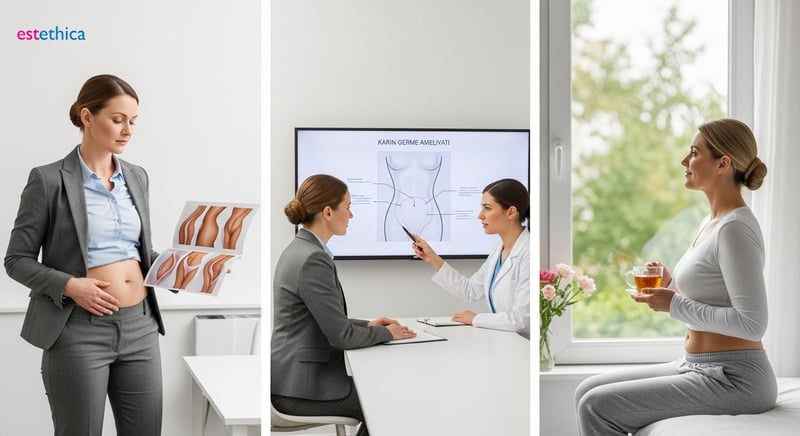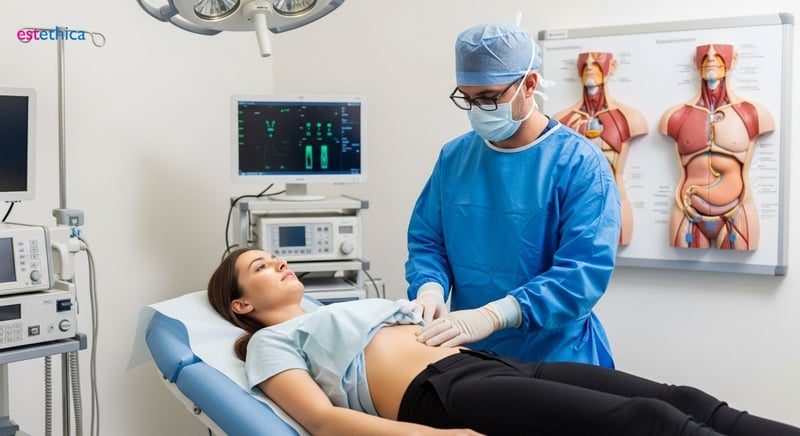Tummy Tuck: Your Journey to a Sculpted Silhouette
Dive into the world of tummy tucks and discover how abdominoplasty can transform not just your body, but your confidence too!
Tummy tuck surgery, known medically as abdominoplasty, is more than a mere cosmetic procedure; it's a transformative journey that enhances both appearance and confidence. This guide delves into the complexities of abdominoplasty, shedding light on the candidacy requirements, the recovery process, and the potential for beautiful body contouring post-surgery. Whether you're evaluating your options or preparing for recovery, this guide aims to inform and assist you every step of the way.
Decoding Abdominoplasty: More Than Just a 'Tummy Tuck'
Understanding the Abdominoplasty Procedure
Abdominoplasty, commonly known as a tummy tuck, is a surgical procedure designed to reshape and firm the abdomen. It involves the removal of excess skin and fat from the middle and lower abdomen and can also include the tightening of abdominal muscles. This procedure is particularly beneficial for individuals who have experienced significant weight loss or pregnancy, which can result in stretched skin and weakened abdominal muscles. The goal of abdominoplasty surgery is to create a smoother, firmer abdominal profile that enhances body contours. For example, a patient who has lost a substantial amount of weight might opt for a tummy tuck to remove the excess skin left behind. A recent study showed that 85% of patients who underwent abdominoplasty reported a significant improvement in their body image and self-esteem. Similarly, women who have had multiple pregnancies may choose this procedure to restore their pre-pregnancy abdominal shape.
Key Components of Abdominoplasty
- Skin Excision: Removal of excess skin to eliminate sagging and improve abdominal contour.
- Fat Removal: Liposuction may be used in conjunction with abdominoplasty to remove excess fat, enhancing the overall result.
- Muscle Repair: Tightening of weakened or separated abdominal muscles (diastasis recti) to restore core strength and create a flatter abdomen.
An extended tummy tuck, for instance, addresses excess skin and fat extending to the sides of the abdomen. The tummy tuck before and after results often reveal a dramatic transformation, with patients experiencing a noticeable reduction in abdominal size and improved muscle tone. This comprehensive approach ensures a more sculpted and aesthetically pleasing abdominal appearance. The abdominoplasty procedure is tailored to meet the individual needs of each patient, ensuring the best possible outcome.

Tummy Tuck Recovery: Expert Tips for a Smoother Healing Journey
Effective Pain Management After Tummy Tuck
Managing pain effectively is crucial during the initial recovery phase after a tummy tuck. Typically, your surgeon will prescribe pain medication to help alleviate discomfort. It’s important to take these medications as directed and to communicate openly with your healthcare provider about the level of pain you’re experiencing. Alternative methods, such as applying cold compresses to the abdominal area, can also help reduce swelling and numb the area, providing additional relief. Gentle movement, like short walks around the house, can improve circulation and prevent stiffness, but it’s essential to avoid strenuous activities that could strain the surgical site. For instance, practicing deep breathing exercises can aid in relaxation and reduce pain perception. Patients who proactively manage their pain tend to have a more positive and comfortable recovery experience. Remember, consistent and appropriate pain management is key to a smoother healing journey after a tummy tuck surgery.
Essential Steps for Post-Operative Care
- Wound Care: Keep the incision site clean and dry to prevent infection. Follow your surgeon's specific instructions for dressing changes and hygiene.
- Compression Garments: Wear compression garments as directed to reduce swelling, support the abdominal tissues, and promote proper healing.
- Limited Activity: Avoid strenuous activities, heavy lifting, and excessive bending or twisting for several weeks to allow the tissues to heal properly.
Proper post-operative care is essential for a successful tummy tuck recovery. Attention to detail in wound management, including regular cleaning and inspection for signs of infection, can significantly impact the healing process. Wearing compression garments not only minimizes swelling but also helps the skin retract smoothly, contributing to a better aesthetic outcome. For example, patients should ensure the garment fits snugly without being too tight, to avoid circulation issues. A study indicated that patients who adhered strictly to post-operative care instructions experienced a 30% reduction in complications. Furthermore, maintaining a balanced diet rich in protein and vitamins supports tissue repair and boosts the immune system. Prioritizing rest and avoiding stress are also important components of a smooth and effective recovery after abdominoplasty. Remember to consult with your surgeon if you are looking for tummy tuck near me.

Am I a Good Candidate? Essential Factors for Tummy Tuck Success
Assessing Your Physical Health for Abdominoplasty
Determining if you are a suitable candidate for a tummy tuck involves a comprehensive evaluation of your physical health. Ideal candidates are generally in good overall health, as certain medical conditions can increase the risk of complications. For instance, individuals with significant heart or lung disease may not be suitable for elective surgery. A thorough medical history and physical examination are essential to identify any potential risks. It's also important to discuss any pre-existing conditions, such as diabetes or autoimmune disorders, with your surgeon. A stable immune system is crucial for proper healing and minimizing the risk of infection. Patients should also be non-smokers, as smoking can impair blood flow and delay the healing process. Those considering tummy tuck surgery should aim to optimize their health through a balanced diet and regular exercise prior to the procedure. A recent survey indicated that patients with controlled medical conditions experienced a 20% reduction in post-operative complications. Prioritizing your health is a critical step in ensuring a safe and successful abdominoplasty.
Key Considerations for Tummy Tuck Candidacy
- Weight Stability: Maintaining a stable weight for at least six months prior to surgery is crucial for optimal results.
- Realistic Expectations: Understanding the limitations and potential outcomes of the procedure is essential for satisfaction.
- Commitment to Aftercare: Being prepared to follow post-operative instructions diligently is vital for a smooth recovery.
Ideal candidates for a tummy tuck typically have realistic expectations about the results. While abdominoplasty can significantly improve the abdominal contour, it is not a weight-loss solution. For example, patients who have achieved a stable weight after bariatric surgery may benefit from a tummy tuck to remove excess skin. A good candidate is also committed to following all post-operative care instructions, including wearing compression garments and avoiding strenuous activities. Additionally, emotional stability plays a role, as patients need to be prepared for the emotional aspects of surgery and recovery. For instance, having a strong support system can help manage any anxiety or stress associated with the procedure. People often search for 'tummy tuck near me' to find local specialists who can assess their suitability. In summary, the best candidates are those who are physically and emotionally prepared for the tummy tuck process and have a clear understanding of what the surgery can achieve.

Beyond the Incision: Exploring Body Contouring After a Tummy Tuck
Combining Liposuction with Tummy Tuck for Enhanced Results
A tummy tuck is often a transformative procedure, but combining it with liposuction can yield even more impressive results. Liposuction targets and removes stubborn fat deposits that may persist even after a tummy tuck, enhancing the overall contour of the abdomen and flanks. This combination approach allows for more comprehensive body sculpting, creating a smoother, more defined silhouette. For instance, liposuction can be used to refine the upper abdomen or love handles, areas that a tummy tuck alone may not fully address. Patients who opt for this combined approach often experience a more dramatic improvement in their body shape. A recent study revealed that 92% of patients who underwent a tummy tuck with liposuction reported higher satisfaction rates compared to those who had a tummy tuck alone. By strategically removing excess fat, liposuction complements the skin tightening effects of a tummy tuck, resulting in a more sculpted and proportionate appearance. This synergy between the two procedures can provide patients with a more refined and aesthetically pleasing outcome. People often search for "tummy tuck before and after" to see the effects of this procedure.
Non-Surgical Options to Complement Your Tummy Tuck
- Skin Tightening Treatments: Radiofrequency or ultrasound therapies can further tighten the skin after a tummy tuck, improving skin elasticity and reducing the appearance of fine lines.
- Muscle Stimulation: Non-invasive muscle stimulation devices can help strengthen and tone the abdominal muscles, enhancing the results of the muscle repair performed during the tummy tuck.
- Cellulite Reduction: Treatments like laser therapy or injectables can target cellulite in the treated area, creating a smoother skin surface.
Exploring non-surgical treatments can further enhance the results of a tummy tuck. These options can address concerns like skin laxity, muscle tone, and cellulite without requiring additional surgery. For example, radiofrequency treatments stimulate collagen production, leading to firmer and more youthful-looking skin. Muscle stimulation devices can help improve abdominal strength and definition, complementing the muscle repair done during the abdominoplasty. Additionally, treatments aimed at reducing cellulite can create a smoother skin texture, enhancing the overall aesthetic outcome. A combination of surgical and non-surgical approaches can provide a comprehensive solution for achieving a more sculpted and toned abdominal area. Patients should consult with their surgeon to determine the most appropriate non-surgical treatments to complement their tummy tuck and achieve their desired aesthetic goals.
Advanced Abdominoplasty Techniques: Combining Muscle Repair and Skin Excision for Enhanced Body Contouring
Prioritizing Patient Safety and Comfort in Tummy Tuck Recovery with Expert Post-Operative Care
Frequently Asked Questions
What is a tummy tuck and how does abdominoplasty reshape the abdomen?
What can I expect during the tummy tuck recovery process?
Who is considered a good candidate for abdominoplasty?
Can liposuction be combined with a tummy tuck for enhanced results?
What are the key components of the abdominoplasty procedure?
Ready to discover your healthiest, most beautiful self with estethica's award-winning care?
📞 Book Your Free Consultation!